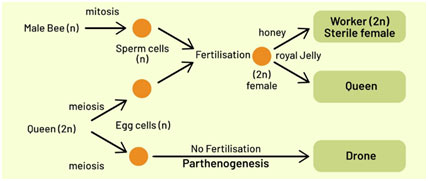Definition
The word parthenogenesis originates from the Greek word, Parthenos = virgin; genesis = origin. When an unfertilized ovum forms into a new individual just after the fertilization however in certain instances the development of the egg occurs without the fertilizing.
This strange setting of sexual reproduction in which egg development happens without fertilizing is known as parthenogenesis. An organism that has developed parthenogenetically is called a parthenogenone or parthenote.
The phenomenon of parthenogenesis happens in different groups of the animals as in specific insects such as Hymenoptera, Homoptera, Coleoptera, crustaceans, rotifers and likewise in some animals such as a number of desert reptiles, turkeys as well as some mammals.
Types of Parthenogenesis
The parthenogenesis might be of two kinds:
- Natural parthenogenesis
- Artificial parthenogenesis
In certain animals, parthenogenesis happens frequently, regularly, and naturally in their life cycles and is referred to as the all-natural parthenogenesis. The natural parthenogenesis might be of two kinds, viz., complete or incomplete.
Complete parthenogenesis
Specific insects have no sex-related phase and no males. They depend solely on the parthenogenesis for self-reproduction. This sort of parthenogenesis is called complete parthenogenesis or obligatory parthenogenesis. It is located in some varieties of earthworms, bdelloid rotifers, grasshoppers, roaches, phasmids, moths, gall flies, fishes, salamanders, and lizards.
Incomplete parthenogenesis
The life process of specific insects consists of two generations, the sexual generation and also parthenogenetic generation, both of which alternate to each other. In such instances, the diploid eggs create females, as well as the unfertilized eggs, generate males. This kind of parthenogenesis is referred to as partial or incomplete or cyclic parthenogenesis.
Natural Parthenogenesis in Vertebrates
A couple of situations of natural parthenogenesis have additionally been reported in the animals. The fish Carassius auratus gibelio is reported to include females just. Also, males are found entirely doing not have in the lizard Lacerta sexicola armeniaca. In it, females are reported to be originated by parthenogenesis.
In turkeys, 80 percent of nurtured eggs reveal very early cleavage phases. Such parthenogenetic types have hatched and expanded to recreating grownups which are found to be diploid males with ZZ sex chromosomes. In mammals also, approximately 60 percent of hamster eggs come to be spontaneously turned on and develop up to the two-cell stage.
Artificial Parthenogenesis
The eggs which constantly develop into the young individuals by the fertilization in some cases may create parthenogenetically under particular artificial conditions. This kind of parthenogenesis is known as artificial parthenogenesis. The artificial parthenogenesis might be generated by numerous physical as well as chemical ways.
A. Physical means:
The adhering to following physical methods causes parthenogenesis:
i. Temperature
The variety of temperatures might generate parthenogenesis in the eggs. For example, when the egg is transferred from the 30o C to 0– 10o C the parthenogenesis is caused.
ii. Electrical shocks can trigger parthenogenesis.
iii. Ultraviolet light can cause parthenogenesis.
iv. When the eggs are punctured by the great glass needles the development of offspring takes place parthenogenetically.
B. Chemical means:
The complying with chemicals has been located to cause parthenogenesis in the normal eggs:
- Chloroform
- Strychnine
- Hypertonic and Hypotonic Sea waters.
- Chlorides of K+, Ca++, Na++, Mg++, etc.
- Acids as butyric acid, lactic acid, oleic acid, and various other fats.
- Fat solvents, e.g., toluene, ether, alcohol, benzene, and acetone.
- Urea and sucrose
The artificial parthenogenesis has been generated by above discussed physical and chemical ways by different researchers in the eggs of the majority of echinoderms, mollusks, annelids, amphibians, birds as well as mammals.
Significance of Parthenogenesis
- Parthenogenesis works as the method for the resolution of sex in the honey bees, wasps, etc. and it supports the chromosome theory of inheritance.
- Parthenogenesis is one of the most straightforward, secure, and very easy procedures of reproduction e.g., aphids (insects).In aphids, parthenogenesis is a way of quick reproduction; the females reproduce by diploid parthenogenesis during summertime.
- The parthenogenesis removes the variant from the population but urges the growth of the advantageous mutant individuals.
- Parthenogenesis causes polyploidy in the organisms.
- As a result of the parthenogenesis, there is no requirement for the organisms to squander their energy in the process of breeding however it enables them to make use of that amount of power in feeding as well as reproduction.
- Honey bee and other social bugs also regulate their sex ratio by parthenogenesis.

